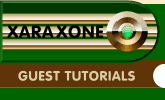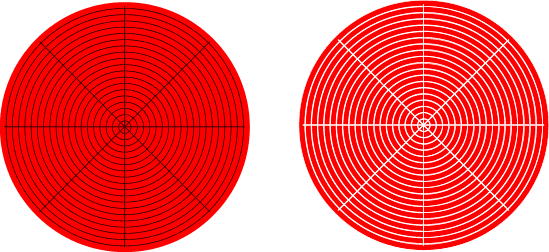|
|
|
We have covered quite a lot of ground already, more than I had originally anticipated, so we have an opportunity to revisit the base plate and give it a lot more interesting detail. The engravings are all ellipses, or parts of ellipses, and my initial version had no text on it at all. The image below is a copy of the template I made for subtraction.
I should explain that I modeled the astrolabe loosely on a JPEG of a historical image. I imported the jpeg and set it as a background layer, and traced the basic shape of the astrolabe over it, especially the rete, the complex piece with all the bars and curved pointers. However the detail wasn't clear enough for any of the engraved markings, so while looking for other source material that could give me the detail I wanted, I found a Java application of an astrolabe available for free on the Internet, (search for Keith's Astrolabe) and took screen dumps from it ( Alt-PrintScreen, then Paste into Xara X), and set them in Xara X with Stained Glass transparency, adjusted for size to match the traced shapes from the JPEG image, and created the curves of the engravings with these as reference. That allowed me to make the astrolabe specific for my latitude, 56 degrees North, and it also enabled me to identify most of the stars the curved pointers were indicating, so that I could then label the pointers correctly. The higher north your latitude, the more central and circular on the base plate the ellipses become, till at the North Pole the ellipses would all be circles centred in the base plate, with eight straight lines radiating out from the centre. For our purposes here, this is a much simpler pattern that we can easily recreate, so we will make our sky centred on the North Pole. If you want it to be properly accurate, then by all means trace your own from something like Keith's Astrolabe. 500pix circle again, no fill, clone, and reduce the clone to a 25pix circle, centred on the larger one. Select both circles and blend, with 18 steps, then Convert to Editable Shapes. Then draw 8 lines diametrically across the outside circle. Select everything and make them all 1pt thick. Select the largest circle and give it a red fill, and 0pt thickness, and put it to the back.
Now select the other circles/lines, and Convert line to Shape. This is the important bit: starting with the circles, select each shape plus the red circle and subtract shapes (Ctrl-2). You should see the white of the background peeking through. Repeat this for all the circles, subtracting them from the red circle. Now you can safely subtract the vertical and horizontal lines, but not the 45 degree lines. Before attempting to subtract the 45 degree lines, rotate the whole lot 45 degrees, making those last two lines horizontal and vertical, and now they can be safely subtracted. Don't ask me why it should make a difference, it just does, right! This avoids Xara X having the little moments I mentioned earlier, so all our gently curved lines are still gently curved, and we have no more and no less nodes than we should have. If you wish to experiment here, feel free, you can always hit Undo. If you subtract the lines first, and then the circles, you end up with the subtracted circles appearing as a series of short straight lines, not smooth curves. The red circle is now ready to export to Xara 3D-6, and it is already the right size. So in Xara 3D-6, select the base plate shape, ensuring it is highlighted, and import/paste our new base plate. It should take on the attributes of the old one, and the new details make it much more interesting to look at.
Now that you have a bit more engraved detail to see, you can do some more tweaking of light positions and angles of view to get the best effect, but essentially you should by now have a good grasp of the methods I used to make the astrolabe. On the next page, Iíll show you some screen captures from Xara 3D-6.
|
|
The Xara Xone Guest Tutorials ©2005 Gary W. Priester All rights reserved
|




